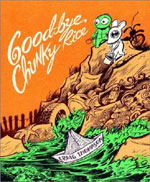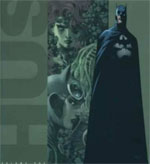
The simplest and best idea in comics this year was a satirical bullseye in the tradition of punk-style detournement. Take a selection of strips from classic romance comics of the 50s and 60s and redub them with modern dialogue. The result - TRUER THAN TRUE ROMANCE, a hearty slice of downbeat humour that contrasts the sacharine world of pre-AIDS four-colour love with today's obsessive self-loathing. It's an interesting use of double-thick comic text, with the laughs also containing a critique of the suppresed nature of these old strips - for instance, the story where the lead female character's relationships fail because she keeps dating effeminate gay men succeeds becasue it is so obvious that that was the subtext in the original art. Straight men with mascara that thick were not exactly the norm in comics of the time...
Oddly enough, satire-free romance comics have made a recent comeback, and from the unexpected stable of Marvel Comics. Mark Millar's mini-series TROUBLE, which is almost finished now, has slender ties with Marvel's superhero output to soothe the fanboys but is otherwise a genuine (apparently) attempt to break the (surely not exactly massive) slush market. The story is one of teenage sex and its consequences -so far so yawn, and the characters, two straight teen couples, include the two people who will one day give birth to Peter 'Spider-Man' Parker and also the two people who will bring him up, Ben and May. Its photographic covers of scantily clad young women upset some, until Marvel pointed out that those kind of illustrations are what usually sell romance lit to the teen demographic (ugh, that word...). Artistically though it's a non-starter, ticking off every cliche in the book, and the odd bit of nudge-nudge continuity (only Spidey fanboys could dig the "jackpot" ending to issue one) doesn't endear itself any.
GOODBYE CHUNKY RICE is one of those beautiful works that comes along every now and then that makes you want to laugh, cry, then jump up and down repeatedly screaming to non-beleivers "this is what comics are caable of!". An anthropomorphic twosome - a kind of squirrel and tortoise version of the two girls from GHOST WORLD - find their close friendship broken up by the former's desire to move from the city. And the tortoise makes a new friend with a lonely man whose pet bird has died. Basically that's it, plot-wise. But the beauty of the book is its telling - the wonderfully drawn panels that wind their way through space and time, showing us the fairly desolate/lonely present and drawing us back to upsetting events in the characters' childhoods. This is a debut too. You'll notice I've not mentioned the artist/writer's name. That's because I've forgotten it. But I certainly havent forgotten the book and I urge you to find it at your libary or comic/bookshop. (in fact, I've been saying 'tortoise' but I can't even remember if that's correct. I have actually read this, I assure you, and still implore you to do so too. It's definitely a squirrel though)
One artist's name I have no trouble remembering is the uncrowned king of indy comics, Dan Clowes. DAVID BORING is every bit as intricate as his earlier work and is, if anything, more daring, with sudden soap-opera-like shifts in narrative and musings on, amongst other things, memory loss, the death of civilisation, seqential art itself, and how you can tell people's character from the shape of their bottom.
The Alan Moore cottage industry continued to pour out a variety of product, including two biographies, but the highlight has to be the second volume of THE LEAGUE OF EXTRAORDINARY GENTLEMEN, which was begun in 2002 but concluded this year. Taking its cue from 'The War of the Worlds', the members of the League find themselves scattered and vulnerable to attacks from within (the Invisible Man, Griffin, finally shows his true colours) and without (the tripod creatures). The series remained the "intellectual game" of Moore's intent, with references to incredibly obscure Victorian literature several layers deep (and one reference to, of all things, the 60's 'Oz' trial!), but wether or not you decide to investigate these further the comic still provided plenty of fun, not least of all Kevin O'Neil's detailed art. And it ended with a punch too.

Money and marketing was as much in the spotlight as ever this year of course. Crossgen had financial-related sacking problems, Marvel decided to wind down its 'Epic' imprint in order to concentrate on yet more books that could be picked up as movies (this in the same year it trumpeted the imprint's promise of greater writer/artist independence), and Fantagraphics announced severe troubles of their own, with this site's very editor one of the many to implore the reading public to buy more of their stuff. Hopefully 2004 will be better for them cash-wise.
Talking of money-making opportunities, it was a big year for movies based on comics, albeit all superhero-based epics. Your opinion of these films probably depends on how seriously you can take grown men and women darting about in improbable leather costumes whilst evading some computer-animated monstrosity. But one of this year's best comics is to be one of next year's most interesting films. FABLES is Bill Willinghams' minor masterpiece about a New York community of fairy tale characters, who have all fleed their magical storybook world to evade the evil of an as-yet un-named 'Adversary'. The story 'Animal Farm' in particular was a hoot as, with a nod to Orwell, the Fables unable to pass for human decided to break free from their farmhold prison. The main attraction of the comic is the increasingly-widespread notion of presenting fictonal characters as being in fact 'real', and able to interact in a recognisably real world. How the subtleties of the comic are to remain in the movie version is unknown however - apparently, the script destroys any mystery by naming the 'Adversary' on page ten.
Last but not least... It's unfair for any reviewer to make any claims as to the 'best' of the year, but my personal favourite of the year, in a tie with the superheroic shenanigans of New X-Men, was STARTLING STORIES: UNSTABLE MOLECULES.
James Sturm presented in his script a version of the characters fans know as the Fantastic Four - except not only was this supposedly a historical piece of drama-documentary about these 'real' heroes, it placed them in the 1950s - at a time before the incident that would cause them to become super-powered. Thus we have a four-part series that isn't about suerheroes at all. Instead, it's about how people lived in such paranoid, restrictive times. Sue Storm here is a put-upon housewife trapped within her role as a welcome mat for the men in her life, and who desperately loathes the anti-Semitism of the local women that share her book group; Johnny Storm is a sexually frustrated teen bewitched by the Beat movement (in its opening pages we actually see him masturbating to the adventures of a comic book heroine, 'Vapour Girl'); Ben Grimm is a down-at-heel alcaholic boxing coach; and Reed Richards is a chauvinistic scientist pushed into a project by a US government determined to beat the Russians into space.
It's a series with real pathos and power, and the attention to detail is impressive, with each issue containing supposed bibliographical notes and other information. If you're a fan of the 'proper' Fantastic Four, this explains just why the quartet developed the powers they did - each member suffers from a particular psychological fixation that their power personifies, e.g. Sue Storm equals lack of self-esteem equals 'the Invisible Girl'.
And if you're not a fan, the story reads fine on its own - an excellent comic strip that peels back the facade of American 50s nostalgia and reveals its ugly, disgusting/disgusted innards to the world.
And Guy Davis' art is good too.
© 2003 David MacGowan